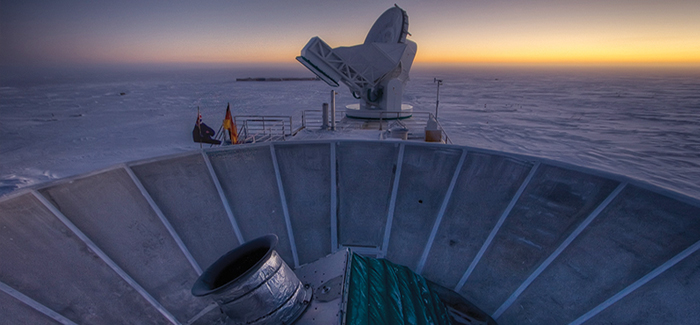
(National Science Foundation/Steffen Richter, BICEP)
Scientists find signs of gravity waves that sparked the newborn universe’s growth spurt.
This March, when researchers announced evidence of gravitational waves that rocked the infant universe in its first nanosecond, crucial support for modern theories of cosmology, the news sparked a big bang of its own in scientific circles. Harvard University astrophysicist John Kovac, PhD’04, leads the collaboration, called Background Imaging of Cosmic Extragalactic Polarization 2 or BICEP2, that found the evidence.
The cosmic microwave background, discovered in 1965, is radiation emanating almost evenly from every direction in the sky. Its existence is powerful evidence for the theory that the universe began in an explosive big bang. As cosmology refined that theory throughout the late 20th century, scientists came to believe that certain features of the universe could only come about if it had expanded incredibly rapidly—from smaller than an atom to even larger than we can observe today—in its first millionth of a trillionth of a trillionth of a second.
One of the predictions made by this theory of inflation was that gravitational waves would have left their imprint on the infant universe by polarizing the microwave radiation into vortex-like patterns, called B-modes. “Inflation has been a successful model because it explains many of the aspects of the universe” as observed, Kovac says, but its prediction about polarization of the cosmic microwave background makes it unique. “There’s no reason to expect that feature under any other scenario.” Detecting the B-modes would mean cosmologists were on the right track.
On March 17, the BICEP2 collaboration (with 47 researchers at 11 institutions, including UChicago assistant professor of physics Abigail Vieregg and Kavli Institute for Cosmological Physics fellow Christopher Sheehy, PhD’13) announced that it had detected the polarization in the B-modes. It was, if anything, a stronger effect than the theorists had predicted, and other cosmologists hailed the news as “the smoking gun of inflation.” John Carlstrom, University of Chicago professor of astronomy and astrophysics and a former adviser of Kovac’s, calls it “one of the biggest discoveries in physics of my lifetime.”
Kovac has spent his adult life on a quest to understand the cosmic microwave background. His search for the answers began as an undergraduate at Princeton University, where he stayed on after graduation, working on a project for Mark Dragovan, AB’80, PhD’86. When Dragovan accepted a position at UChicago, Kovac accompanied him. There he began working with Carlstrom on an experiment at the South Pole called the Degree Angular Scale Interferometer, which attempted to detect small variations in the intensity of the microwave background called anisotropies. The South Pole is a popular location for observations of the cosmic microwave background, since the dry, clear air absorbs little microwave radiation.
In 2002 Carlstrom’s experiment reported the first detection of polarization in the microwave background, and Kovac was the lead graduate student author on the resulting paper. Carlstrom followed that with research using a more sensitive instrument called the South Pole Telescope, still in operation today. Also at the pole was the original BICEP experiment, which ran from 2005 to 2008; its successor, the improved BICEP2, took place from 2010 to 2012.
Kovac is now focused on the work still to be done, saying that there is much more data to analyze from the BICEP2 experiment, including additional observations from more frequencies and larger swaths of the sky. He hasn’t even allowed himself to celebrate the results that caused such reverberations this spring. “My role in this process has been to remain calm at all times,” Kovac told Nature.
More answers may yet come from joining forces with Carlstrom’s South Pole Telescope project too: “We’re looking forward to combining our data with those guys,” Kovac says. Together, they can tease out finer details of the process of inflation. And that, he says, is a big step toward understanding the true nature of the laws of physics.
